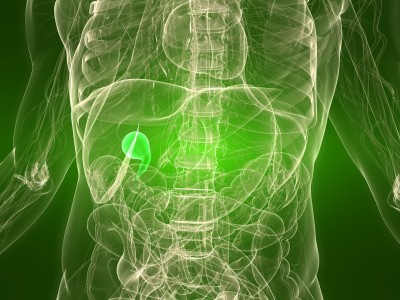The gallbladder is a pear-shaped organ connected to the liver that stores and concentrates bile. Porcelain Gallbladderis also known as calcified gallbladder, calcifying cholecystitis, or cholecystopathia chronic calcarea. It is defined as calcium based incrustation of gallbladder wall. It appears as hard and bluish and the texture resembles as that of porcelain ceramic. It is known to result from a chronically inflamed organ wherein the gallstones collected in the gallbladder becomes irritated and precipitates a buildup of calcium or calcium salts. The occurrence of gallbladder carcinoma in patients with a calcified gallbladder ranges from 7% to 33%.
Calcification occurs in the gallbladder when thickening and hardening of the wall occur. The gallbladder stores acid needed for breaking the foods called bile. It is produced in the liver and transferred to the gallbladder via cystic duct. It is then passed in the small intestine in the right amounts to break the fats. When the bile is not successful in breaking down all the fats, the extra cholesterol will crystallize and form small gallstones which have the tendency to lodge the bile ducts and limit the flow of fluid. Too much formation of gallstones will result to duct blockage causing infections and inflammation of the gallbladder. If this condition continues, hardening and thickening of the gallbladder wall will occur.
What are the symptoms?
This disease is asymptotic though in some cases, symptoms such as abdominal pain that increases after eating, vomiting, and jaundice are experienced. Jaundice is the yellowish pigmentation of the skin and often seen in liver diseases. Some people can experience gallstone symptoms such as persistent pain in the right upper abdomen and under the right shoulder, fever, nausea, restlessness, belching, and indigestion.
Women are five times more prone than men to suffer this condition though incidence is less than 1% for the overall population. The risks for gallstones’ formation include gender, age, obesity, rapid weight loss, pregnancy, hormone therapy, and birth control pills. The gallstone formation increases with age and a diet that includes high fat foods and low-fiber diet. Rapid weight loss and exaggerated low-calorie diet can disturb the bile chemistry.
Medical Treatment:
It can be detected by CT scan, X-ray, or ultrasound and appears as a visible dense sac beside the liver. The stronghold of treatment for porcelain gallbladder is cholesytectomy, a surgery performed to take out the gallbladder.
How to prevent calcification in the Gallbladder?

A low fat and high fiber diet will help in reducing the gallbladder formation. Studies show that vegetarians have low risks in diseases related to the gallbladder. Here are some foods to be avoided or consumed only in minimum quantities:
- All animal fats (beef, pork, butter, lard)
- Dairy products (whole milk, cheese)
- Hydrogenated oils and fats (mayonnaise and margarine)
- Refined carbohydrates (cakes and pastries, white bread, beans, corns and nuts)
- Deep-fried foods (chips)
- Stimulants (black tea, coffee, alcohols)
- Carbonated beverages (sodas, colas)
- Eggs due to high cholesterol
- Sugar-Rich Foods (chocolates, candies, ice cream)
The gallbladder diet includes soybean products (tofu), lentils, beans, and whole grains. It should be rich in salads and sprouts. People with gallstones should eat foods that:
- Contains unsaturated fatty acids (olive oil, nut and seed oils)
- Poly-unsaturated fatty acid (omega 3 and omega 6 fatty acids)
- Rich in calcium, potassium, magnesium (to keep the body alkaline)
The foods recommended are steamed vegetables, baked potatoes, brown rice, broiled fish, fresh fruits and vegetables, apple butter instead of jam, yogurt, soaked and sprouted beans. Also, drink a lot of water and other fluids. Regular exercise is necessary to reduce obesity and maintain normal weight. Studies show that regular exercise can normalize blood sugar and insulin level. One research by WebMD showed that men performing regular jogging, running, and brisk walking for 30 minutes five times a week have 34% reduction in the risk of gallbladder diseases.
There are some researches that suggest taking non-steroidal anti-inflammatory drugs (NSAIDS) like aspirin and ibuprofen to fight gallstones formation. However, one study denied this claim. It found that there is no difference in the risk of gallstone formation in over 400 chronic patients who took NSAIDS regularly. Another medication approved by FDA for obese patients is a drug called Actigall which is used for carefully selected patients since 1998.